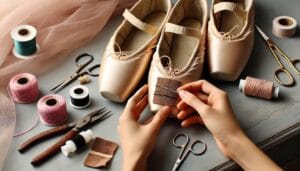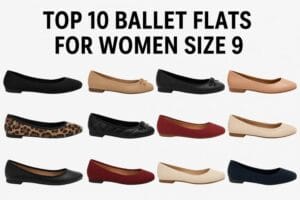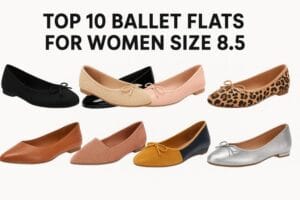Do Ballet Flats Work with Orthotic Footbeds (10 Questions Answered)
- Published on -
- By - Tabitha Simmons
- Reviewed by - Tory Burch
- Reading Time - 13 Minutes

Share this Post
Recent Posts
About Author
Tabitha Simmons
In this article, we answer 10 common questions about wearing orthotics with ballet flats, helping you find the perfect balance between comfort and style.
What Features Should you Look for in Ballet Flats Designed to Accommodate Orthotic Footbeds?

Ballet flats that are traditional in design aren’t made to fit heavy or rigid orthotic footbeds due to their thin profile and small structure. But, with the proper adjustments and options, you can wear ballet flats comfortably while wearing orthotics.
1. Select Flats with Removable Insoles
Tip: Look for ballet flats that permit the user to remove the insole.
Solution: This extra space allows you to insert your orthotic of your choice without compromising comfort.
2. Select Deep and Roomy Designs
Tip: Opt for flats with a more rounded sole and a wider box.
Solution: These features provide the space needed to accommodate orthotics, so your foot isn’t strained.
3. Use Low-Profile Orthotic Inserts
Tip: Consider slim, flexible orthotics that don’t add excessive weight.
Solution: These styles have been made to blend seamlessly into minimalist ballet shoes, such as ballet flats.
4. Take into Consideration Flats With Built-in Support
Tip: Some modern ballet flats have a higher arch support.
Solution: These shoes reduce the requirement for an additional orthotic by offering a unified support.
5. Explore Professional Modifications
Tip: If your favorite pair of shoes isn’t fitting, you should visit a shoe repair shop.
Solution: A cobbler can modify the shoe’s structure to allow room for an orthotic insert.
Q2. Do you have the Ability to put Orthotics Inside Ballet Shoes?

Ballet flats are adored for their design and comfort, but many are unsure if they are used with orthotic footbeds. Although not all ballet flats have been designed to offer additional comfort, they do have a few ways to get it done. Here’s a brief guide that offers practical suggestions and solutions:
1. Check for Removable Insoles
Tips: Look for flats with a removable insole, which can be changed.
Solution: Change the original insole with a custom orthotic to ensure proper support.
2. Opt for Slim, Low-Profile Orthotics
Tip: Choose thinner orthotic inserts specifically designed for flat shoes.
Solution: Talk to your orthotist for low-profile solutions that can provide assistance without altering the fit of the shoe.
3. Consider Shoe Modifications
Tip: If your favorite ballet shoes are a bit tight consider professional adjustments.
Solution: Visit a cobbler who will be able to stretch or alter the design of your shoe to fit your orthotic.
4. Explore Built-In Support Options
Tip: Some flats offer arch support built-in, which reduces the need to add additional inserts.
Solution: Find out and select designs that are able to support your feet. This could decrease the need for separate orthotics.
Q3: Why do Podiatrists Dislike Ballet Shoes?

Ballet flats are unquestionably fashionable and comfortable for a lot of people However, podiatrists generally advise against wearing them often. Their minimalist design could result in foot pain as time passes. Here are the main reasons why podiatrists don’t like ballet shoes, as well as practical suggestions and solutions.
1. Lack of Arch Support
Problem: Ballet flats typically provide only minimal arch support which can cause overpronation and foot pain.
Tip & Solution:
- Tip: Consider models that have built-in arch support, or select flats specifically designed for comfort.
- Solution: Use custom orthotic inserts or supportive insoles to improve stability in the arch.
2. Insufficient Cushioning
Issue: The thin soles of ballet flats provide little shock absorption, causing joint strain and discomfort.
Tip & Solution:
- Tip: Look for ballet flats that boast enhanced cushioning.
- Solution: Add foam or gel pads in order to enhance the shock absorption as well as provide more comfort.
3. Narrow Toe Box
Problem: A constricted toe area could cause your toes to become strained, which could lead to neuromas or bunions over time.
Tip & Solution:
- Tip: Choose flats with more room or flexible toe boxes.
- Solution: Ensure the shoe is sized correctly; if necessary, choose an extra half size or choose a brand that is known for its spacious styles.
4. Minimal Heel Support
Problem: The nearly flat heel of ballet flats provides only a little support. This can affect your posture and your movement.
Tip & Solution:
- Tip: Look for designs with an incline or a reinforced back structure.
- Solution: Use a heel insert or select styles that have enhanced cushioning for your heel to provide support.
5. Lack of Overall Foot Stability
Problem: Without proper structure ballet flats could result in instability, thereby increasing the risk of strains and other injuries.
Tip & Solution:
- Tip: Rotate your footwear and stay away from long periods of flats that aren’t supportive.
- Solution: Combine the use of orthotics that support your feet with the use of a variety of footwear made for different types of activities to safeguard your feet.
Q4. Why are my Feet Hurting in Ballet Shoes?
Flats for ballet are adored because of their minimalist, chic style, but some wearers suffer from pain or discomfort. This is because the shoes typically reduce cushioning and support to fit the design. Here’s a short blog article explaining the reasons your feet may be hurting in ballet flats along with practical suggestions and solutions.
1. Lack of Arch Support
What causes it to hurt: Ballet flats typically are a flat and unsupportive style that could put a strain on your arches.
Tip: Look for flats that have arch support built-in or removable insoles to accommodate orthotics.
Solution: Consider adding cushioned arch supports or orthotic inserts that are custom-made to ease arch pressure.
2. Insufficient Cushioning
Why it hurts: Thin soles mean less shock absorption, which leads to more stress on your feet from every step.
Tip: Try flats with cushioned insoles, or add an elastomer insert under your original insert.
Solution: Invest in memory foam or gel-based insoles that are designed to minimize impact and offer more cushioning.
3. Poor Fit or Tightness
Why it hurts: Shoes that are too tight or don’t have enough space for your feet could result in blisters, pressure points and general discomfort.
Tip: Ensure you’re wearing the correct size and think about testing different sizes.
Solution: If the fit isn’t quite right, talk to a professional in shoe repair to make adjustments for stretching or for brands with an easier fitting.
4. Overuse Without Breaks
What causes it to hurt: Long-term wear and no breaks can cause fatigue to your feet particularly if they aren’t equipped with support features.
Tip: Rotate your footwear throughout the day, and allow your feet a break in order to get back to.
Solution: Make use of supportive footwear to help you stay on your feet. Change to shoes that offer more support when it is possible.
5. Underlying Foot Conditions
What causes it to hurt: Conditions like flat feet and plantar fasciitis are caused by shoes that are not supportive.
Tip: If you have an existing foot issue, choose shoes that are designed to offer additional support and cushioning.
Solution: Consult a podiatrist to get a personalized diagnosis and possibly an orthotic solution that is custom-made to alleviate discomfort.
Q5. What Happens if my Orthotics won't Fit into the Shoes I Wear?
The use of orthotics is essential for many people to maintain the health of their feet and ensure they are comfortable. But, it can be a hassle if the orthotics you are wearing don’t fit in your favorite shoe. Here are some suggestions and solutions to get over this issue.
1. Reevaluate Your Shoe Choice
Tip: Look for shoes that have removable insoles, or extra thickness.
Solution: Select brands or designs that are marked as “orthotic-friendly” to ensure sufficient space to insert your items.
2. Consult a Professional
Tip: Speak with your orthotist or a podiatrist regarding your issues with your shoes.
Solution: They might recommend customized modifications to your orthotics, or suggest specific styles of shoes that will better meet your requirements.
3. Consider Custom Modifications
Tip: Don’t hesitate to go to a specialist in shoe repair or a cobbler.
Solution: The elastic material can be stretched or adjust the interior of your shoe to provide the space to accommodate your orthotics.
4. Explore Alternative Orthotic Options
Tip: Investigate if a slim-profile orthotic or a customized design is available for your needs.
Solution: Switching to a thinner orthotic could resolve the fit issue without the support being compromised.
5. Switch to Orthotic-Friendly Shoes
Tip: If modifications aren’t enough, think about investing in footwear that is designed specifically with orthotic support in your mind.
Solution: A variety of brands provide fashionable options that blend support, comfort and the space needed to accommodate orthotics.
Q6. Who Shouldn't Wear Ballet Shoes?
Flats for ballet are known for their simple design and comfort, but they’re not the best choice for all people. Certain kinds of feet and lifestyles might require a more structured and stable support than the simple shoes provide. Here are a few groups that may struggle with ballet flats, as well as practical suggestions to help you select the best option.
1. Individuals with Specific Foot Conditions
Tip: If you suffer from ailments such as plantar fasciitis or severe flat feet or bunions, the absence of arch support and support for the heel in ballet shoes can cause more discomfort.
Solution: Select shoes with a greater cushioning capacity and stability, like orthotic shoes or supportive sneakers specifically designed to suit your condition.
2. People with Narrow or Irregularly Formed Feet
Tip: Ballet flats are typically created with a standard shape with a general fit. A narrow or unusually shaped foot may find these shoes to loose, which can cause discomfort and instability.
Solution: Look for brands that offer adjustable straps or custom fit. You can also consult a footwear professional to identify flats that can be tailored to a specific shape of your foot.
3. Those Who Stand or Walk for Extended Periods
Tip: If your daily routine is long-lasting walking or standing in the bare minimum of padding and support provided by ballet flats could cause fatigued feet.
Solution: Consider alternating your shoes with cushioned ones when you are doing a lot of physical activity or opt for flats with cushioning features that absorb shock as well as comfortable insoles.
4. People with High Arches
Tip: Ballet flats typically provide only limited arch support, and this can leave people with arches that are high arches without the cushioning and stability.
Solution: Look for flats that have built-in arch support, or opt for orthotic inserts that are thin and specially designed for shoes with a low profile. This helps spread pressure evenly and decrease the strain on arches with high arches.
Q7. What is the Reason Ballet Shoes are Extremely Uncomfortable?
Ballet flats are a classic and elegant choice for footwear; however, many are uncomfortable for long wear. The design of these shoes often puts the fashion aspect over the function and can result in issues such as inadequate support and a lack of cushioning. Here’s a quick look at how they could cause discomfort, along with practical suggestions and solutions.
1. Lack of Arch Support
Problem: Most ballet flats have a flat, non-supportive sole that isn’t able to accommodate an arch that is naturally yours.
Tip: Consider using orthotic or arch-support inserts that are specifically made to fit flat shoes.
Answer: Look for brands or models with arch support built-in for greater stability.
2. Minimal Cushioning
Problem: The thin soles of ballet shoes often offer insufficient shock absorption, which leads to fatigued feet.
Tip: Add cushioned insoles or gel pads to increase the comfort of long hours of wear.
Solution: Choose flats that provide extra padding in the footbed. You can also purchase high-end cushioning from the aftermarket.
3. Poor Fit and Sizing Issues
Problem: A one-size-fits-all approach could lead to flats that are either too tight or loose, leading to blisters and pain.
Tip: Try on different sizes and styles until you find the perfect fitting for your foot shape.
Solution: Look for adjustable options (like straps) or talk to an expert on footwear to ensure the best fitting.
4. Lack of Heel Support
Issue: Even though ballet flats are flat, a few do not have the proper structure that supports the heel, which can cause friction and slippage.
Tip: Use padded heel inserts or liners to hold the heel to keep it in position.
Solution: Choose designs with the heel cup slightly curved to allow your foot to rest naturally.
5. Material and Construction Limitations
Problem: Stiff or non-flexible materials might not be able to conform to your feet, thereby increasing pressure points.
Tip: Select flats made of soft, flexible materials that will mold to the shape of your feet as you age.
Answer: Gradually break in your shoes by wearing them for brief intervals before putting them on for everyday use.
Q8. What is the Reason Ballet Shoes Stink?
Ballet flats are a stylish and comfortable option, however, most wearers are faced with a problem: smelly feet. The style and the materials used in ballet shoes create an environment in which germs and sweat thrive, which can result in unpleasant odors. This is a brief explanation of the reasons for this and the best way to deal with the issue.
1. Limited Ventilation
Issue: The snug design and materials that are often not breathable limit the flow of air, which causes sweat to collect.
Tip: Opt for ballet flats that are made from natural, breathable materials such as leather or ones that have mesh panels.
Answer: Alternate your footwear to allow your feet to rest and let them breathe between each use.
2. Moisture Retention
Issue: Ballet flats tend to hold moisture, resulting in an environment that is damp, which can cause the development of odor.
Tip: Use moisture-wicking insoles or apply an effective powder on your feet to absorb the sweat.
Solution: Keep an extra pair of socks in your bag and change them when your feet become too wet over long periods of time.
3. Bacterial Growth
Trouble: Warm, moist conditions in the flats allow bacteria to flourish and produce odor.
Tip: Practice daily foot hygiene by thoroughly washing and dry your feet.
Solution: Clean your shoes using a disinfectant or odor neutralizing spray in order to prevent the growth of bacteria.
4. Material Quality
Issue: Synthetic materials, found in a variety of ballet shoes, can be more susceptible to retaining odors as compared to natural materials.
Tip: Invest in higher-quality flats or ones made with the control of odor in mind.
Solution: Change your collection of shoes to ensure that each pair has the opportunity to dry completely between wears.
Q9. Are Ballet Shoes Old-Fashioned?
Ballet flats have been a staple of the wardrobe due to their timeless and versatile style. Although some critics say they’re an old fashion, a lot of people still recommend them for their timeless style and comfort. Let’s discuss the issue and give you practical advice to ensure your style is always fresh.
1. Timeless Design vs. Changing Trends
Tip: Recognize that classics are timeless. Ballet flats provide a minimalist style which can be updated with contemporary details.
Solution: Pair your flats with trendy styles (like slim jeans, or an eye-catching dress) in order to achieve a chic modern, contemporary style.
2. Versatility in Every Wardrobe
Tip: Use ballet flats as a foundation for casual and semi-formal outfits.
Solution: Invest in a couple of pairs of neutral colors and play with embellishments or prints to keep up with the latest trends.
3. Comfort and Practicality
Tip: If comfort is your main concern, ballet flats remain the best option in the current frantic world.
Solution: Find designs featuring cushioned insoles, or with added arch support to blend design and functionality.
4. Reinventing the Classic Style
Tip: Update your ballet flats by adding accessories or DIY embellishments such as the ankle straps, or accents made of metallic.
Solution: Discover brands that present modern variations on the classic style, making sure that you get a pair that is at once nostalgic and modern.
5. Sustainable Fashion Choice
Tip: Embrace the sustainability aspect by investing in high-quality ballet shoes that endure year after year.
Solution: Find ethically produced products from brands committed to green practices so that you can keep up-to-date while supporting sustainable fashion.
Q10. Are Ballet Flats Good for Knees?
Ballet flats are popular because of their ease of wearing and flexibility. But, there are always questions concerning whether their simple design could negatively impact knee health. Although they’re not inherently hazardous, certain elements could create knee discomfort as time passes. This is a brief overview with suggestions and strategies to help you get the most enjoyment from the ballet flats you’ve been wearing and keep your knees in your mind.
1. Limited Cushioning and Support
Tip: Look for flats with cushioning components.
Solution: Look for brands with memory foam insoles with integrated shock absorption that can lessen the impact force that are transmitted to your knees.
2. Altered Gait and Alignment
Tip: Be mindful of your walking style in flats as inadequate support could cause small changes in your stride.
Solution: Include orthotic arch support or insoles in order to keep an ideal alignment and lessen the stress placed on your knees.
3. Minimal Arch Support
Tip: Check if your ballet flats offer adequate arch support, particularly in the case of flat feet or any other foot problems.
Solution: Use removable insoles that provide greater arch support. Also, consult an expert for customized orthotics.
4. Long-Term Impact on Joint Health
Tip: Rotate your footwear to reduce the stress on your knees due to wearing flats all day long.
Solution: Change between flats or more supportive footwear to ease joint strain and facilitate recuperation.
5. Personal Foot Mechanics
Tip: Pay attention to the way your body feels after wearing ballet flats for prolonged durations.
Solution: If you experience knee pain, think about consulting with a physiotherapist or podiatrist to determine your gait and shoe requirements.
Conclusion:
Ballet flats are fashionable and comfortable, but they aren’t always supportive enough and can be uncomfortable, or even dangerous for those with foot problems.
While it’s possible to wear small, customized orthotics or insoles for certain ballet flats, the majority of standard pair don’t have enough depth or structure to support them in a proper way. This could cause foot discomfort, swelling, improper alignment, and even conditions such as plantar fasciitis.
Podiatrists are generally against wearing ballet shoes for prolonged periods of time, particularly with flat feet or any other foot issues. If they’re worn, they’ll be comfortable but not too tight. It’s recommended to pick orthotic-friendly and supportive styles to protect your knees, feet, and posture over the long term.






